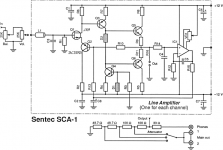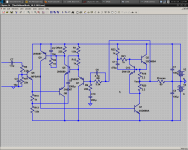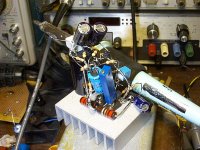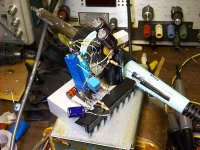Okay, one small new detail.
I've tested the Thiele on and off quite a few times now in the course of normal listening, and I've concluded that my previous observation was wrong. It hardly sounds any different, except at the high frequencies. It sounds "softer", but of all the times I've tested it seemed in a bad way. So I would prefer to go without it.
- keantoken
I've tested the Thiele on and off quite a few times now in the course of normal listening, and I've concluded that my previous observation was wrong. It hardly sounds any different, except at the high frequencies. It sounds "softer", but of all the times I've tested it seemed in a bad way. So I would prefer to go without it.
- keantoken
Is that strange? My brother makes all the same observations as I do, and I never give him any tips beforehand.
It may just be I'm using particularly crappy capacitors. I wouldn't know.
I never expected the input cap would have much of an effect, but it does have one, enough for me to not want to "downgrade". I thought it would be easy to tweak the amp and make it sound great, until it became obvious that cap choices would make or break. I will say that by far the biggest change in terms of impact on listenability of the music however is the compensation. Too much, it will be muffled, too little and it will be harsh. Beyond this, changing input and feedback caps make less noticeable improvements (but of a different type - like apples and oranges). What seems to change is what instruments are brought to the foreground. For some caps, treble dominates, for others it will not be so, but the music will be dull instead. In between these two extremes is where I aim.
Also, consider that I'm driving a 5.4ohm speaker with a headphone amp qualified for 24ohms max power. It will increase most distortions to "high" levels, including those of the feedback DC blocking cap.
Of course, I may be only fooling myself into thinking I hear something I don't. Then again, I would hate to fool myself into thinking what I hear is only in my head.
- keantoken
I've just noticed that you are what, 16 years old I think, and I decided to take a look at some of your threads. It is really a pleasure to see someone so young doing such advanced work and if I can help you in anyway please don't hesitate to message me.
You really have to do controlled tests to determine if your observations are real concerning capacitors. This is a thread that I started on the subject:
Capacitor Myths - The Classic Speaker Pages Discussion Forums
Bob Cordell was involved in that switched capacitor test.
There are situations where capacitor characteristics make an audible difference but it is very rare.
This is an excellent read concerning people who make outrageous claims about what they can hear:
http://www.bostonaudiosociety.org/bas_speaker/abx_testing2.htm
Last edited:
Hello Pete. After much pondering I'm still not sure what to think.
The differences, even if slight, always seem very real. I've been listening to my amp for quite some time now and my observations haven't changed. Before the amp was harsh and bright. Now it's smooth. There was a certain harshness that's unlike any sound I've heard in real life, it was quite audible. Other than that, other things I've heard might just be my imagination or EQ changes.
- keantoken
The differences, even if slight, always seem very real. I've been listening to my amp for quite some time now and my observations haven't changed. Before the amp was harsh and bright. Now it's smooth. There was a certain harshness that's unlike any sound I've heard in real life, it was quite audible. Other than that, other things I've heard might just be my imagination or EQ changes.
- keantoken
Hello Pete. After much pondering I'm still not sure what to think.
The differences, even if slight, always seem very real. I've been listening to my amp for quite some time now and my observations haven't changed. Before the amp was harsh and bright. Now it's smooth. There was a certain harshness that's unlike any sound I've heard in real life, it was quite audible. Other than that, other things I've heard might just be my imagination or EQ changes.
- keantoken
Perhaps one cap is of very low quality ... it is hard to say ...
Or perhaps the amp is misbehaving with one cap and some simple characteristic of the other tames the issue, very hard to say.
I'm able to hear differences in ESR between caps with an A/B switch but it is very subtle.
Nice circuit by the way, it is good to see some new ideas!
I would say don't worry about it, enjoy your work! Perhaps one day you'll hook up a relay to compare different caps.
Last edited:
One thing I've learned is that the ears' sensitivity decreases when you're actually trying to hear something. As such, if you're listening for it you'll never hear it. I can hear my pocketwatch across the room, as long as I'm distracted by something else.
- keantoken
- keantoken
One thing I've learned is that the ears' sensitivity decreases when you're actually trying to hear something. As such, if you're listening for it you'll never hear it. I can hear my pocketwatch across the room, as long as I'm distracted by something else.
- keantoken
I believe that the whole psychoacoustic "thing" is very complex. I understand what you are saying however I find that I have to concentrate to listen for something, then once I identify it and "learn" to hear it, it is easy to detect at a later time ... to the point of being annoying. Clipping is a good example or the high levels of IMD that result from overdriving analog tape. I hear this on certain studio recordings where they probably used the soft overload of analog tape to compress the signal.
Human perception is complex.
You might find some of Sean Olive's publications interesting:
http://www.blogger.com/profile/17909033506833141612
References 9 and 10 at the bottom here are classic AES papers that you can download:
http://seanolive.blogspot.com/
Last edited:
Hearing is 20% mechanics and 80% processing a Masters in acoustics guy who was giving a paid seminar class used to say.
I did! 😉
I wanted a symmetrical output stage which wouldn't turn even harmonics into odd ones. What I settled on was a solution that wouldn't disturb the harmonic profile of the frontend. I first used an Allison, and then I realized it could be made simpler; the Allison became something like an Aleph? Don't remember what exactly, but both circuits share the same thing. Regulate voltage across two equal resistors, and the drive current from their joined ends will be equally shared between them.
This present arrangement could be modified to be more like the Allison, by turning the bias transistor into a Rush pair. I don't remember exactly the benefits, but IIRC the single transistor version was more effective, and using two didn't seem worth it.
- keantoken
I wanted a symmetrical output stage which wouldn't turn even harmonics into odd ones. What I settled on was a solution that wouldn't disturb the harmonic profile of the frontend. I first used an Allison, and then I realized it could be made simpler; the Allison became something like an Aleph? Don't remember what exactly, but both circuits share the same thing. Regulate voltage across two equal resistors, and the drive current from their joined ends will be equally shared between them.
This present arrangement could be modified to be more like the Allison, by turning the bias transistor into a Rush pair. I don't remember exactly the benefits, but IIRC the single transistor version was more effective, and using two didn't seem worth it.
- keantoken
I take it you are aware that a perfectly symmetrical output stage does not produce even harmonics ... rather only odd? So perhaps if your goal is H2 then the JLH output is better.
Even harmonics never completely cancel, unless you have perfect transistors. Even so, the bias transistor is what produces most of the harmonics of this output stage, not the outputs. I tried many options, and this one was the most benign in simulation while being minimally complex.
- keantoken
- keantoken
Even harmonics never completely cancel, unless you have perfect transistors.
snip ...
- keantoken
I said perfect, just to discuss the theory ... OK fine.
The Allison has a pair of "bias transistors" and if as assumed they are perfectly matched and driven from the emitters ... then you know the outcome.
Last edited:
I wonder if that's one of Thomlinson Holmman's designs.
The difference is that in my circuit, there is only one "allison" transistor, not two driven 180deg out of phase. This gives the circuit a normal monotonic spectrum.
- keantoken
The difference is that in my circuit, there is only one "allison" transistor, not two driven 180deg out of phase. This gives the circuit a normal monotonic spectrum.
- keantoken
Nevermind ...Noticed this while perusing some manuals I downloaded a while ago, thought some might find it of interest
Rgds
James
It seems that R2 has the largest affect on listenability. If it is too low, the sound will be harsh. After that is C2. Again, lower is better.
In HeadRush version 457, I replaced C6 and C3 with NP0 ceramics I pulled out of an ancient TV tuner. Stability improved quite a bit. I transplanted the SD669A's I got from an old monitor.
- keantoken
In HeadRush version 457, I replaced C6 and C3 with NP0 ceramics I pulled out of an ancient TV tuner. Stability improved quite a bit. I transplanted the SD669A's I got from an old monitor.
- keantoken
Attachments
Doesn't sound as warm now, but realism has improved. I think the output transistors are what made the biggest change.
- keantoken
- keantoken
Okay, I FINALLY fried my last prototype, and couldn't figure out what went wrong.
It was a cruel accident of fate. The patient was operated on without anesthesia, so was still active during the procedure. With no speaking apparatus, there was no way to tell the surgeon.
Anyways, I made a totally new prototype. Before this happened I was going to replace the trimmer in the compensation network with a resistor and see if that would improve stability. This time I took the liberty of updating the wiring scheme. I was going to wait until I had new transistors from the same batch, but I tried listening to my computer on headphones and I couldn't stand it. This amp sounds so natural and detailed, with a sense of space that makes the music seem more real. It also sounds beautiful with music that wasn't recorded in a realistic way. Even on speakers this is all very evident.
I used the best transistors in my junkbox:
PN200A
MPSA18
2SC945P
2N4124
2SD669A/B649A
All very fast transistors. And Lol, it's still not in stereo.
I will have to fix my signal generator soon, so I can test it and other things.
- keantoken
It was a cruel accident of fate. The patient was operated on without anesthesia, so was still active during the procedure. With no speaking apparatus, there was no way to tell the surgeon.
Anyways, I made a totally new prototype. Before this happened I was going to replace the trimmer in the compensation network with a resistor and see if that would improve stability. This time I took the liberty of updating the wiring scheme. I was going to wait until I had new transistors from the same batch, but I tried listening to my computer on headphones and I couldn't stand it. This amp sounds so natural and detailed, with a sense of space that makes the music seem more real. It also sounds beautiful with music that wasn't recorded in a realistic way. Even on speakers this is all very evident.
I used the best transistors in my junkbox:
PN200A
MPSA18
2SC945P
2N4124
2SD669A/B649A
All very fast transistors. And Lol, it's still not in stereo.
I will have to fix my signal generator soon, so I can test it and other things.
- keantoken
Attachments
Even MIDI sounds good with this amp. Imagine that!
Just got Synthfont working on linux... Maybe I'm hallucinating though... No way MIDI can sound this good...
- keantoken
Just got Synthfont working on linux... Maybe I'm hallucinating though... No way MIDI can sound this good...
- keantoken
- Status
- Not open for further replies.
- Home
- Amplifiers
- Headphone Systems
- Rush Cascode Headphone Amp + JLH Output Stage



